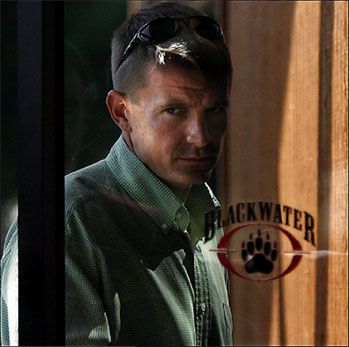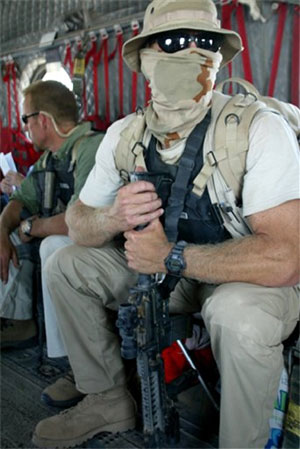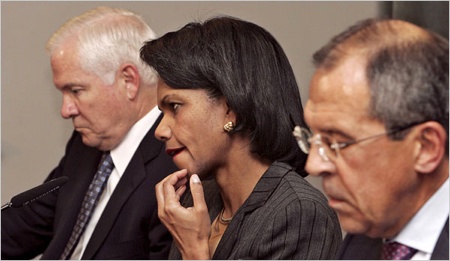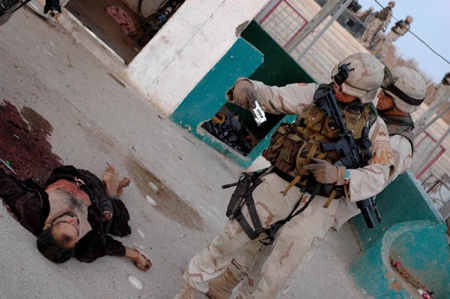Notes
Seeing The Enemy
(This is a post in two parts, one appearing here and
the other appearing at No Caption Needed.)

“If you stare into the abyss long enough …”
by John Louis Lucaites and Robert Hariman
He is the Prince of Blackwater, Erik Prince, founder and CEO of Blackwater, Worldwide, the largest and most notorious of more than 180 private contractors—mercenary firms— hired by the U.S. government to “fill the gaps” of security in Iraq to the tune of tens of billions of dollars. He is something of a recluse, but in recent times he has become the public face of America’s privatized, “shadow army” which currently hosts more personnel on the ground in Iraq than the U.S. military.
The photograph above, which appeared in this week’s Washington Post, is ominous and foreboding. Shot through a glass door, the viewer is separated from Prince by an invisible barrier that is marked by the Blackwater brand. Cast in dark shadows and apart from the contrasting light, he is framed at a slight but nevertheless low angle that puts the viewer just beneath the line of sight of his icy cold stare, a look which expresses his utter contempt for those on the other side of the glass, and by extension all that they stand for, including the rule of law.
It is easy to imagine the head of Blackwater as the Prince of Darkness, and the media have done a pretty good job of that. But what if Prince is a scapegoat for our collective sins and the all too easy willingness of the American public to allow their government to fight a war on the cheap, or in a way that sidesteps accountability? What if, when we stare into the abyss that is Blackwater and all that it stands for in Iraq, the abyss stares back at us? What then do we see?
One possibility is the following photograph that we came across in The Daily Telegraph while traveling in England recently.

It is a rarely seen AP image of private security guards accompanying Paul Bremer on a trip to Basra in 2003. We have no evidence that it was published when taken, and it is not hard to see why it might not have been on the front page of newspapers or on the nightly news. Dressed in generic war garb, there is nothing that necessarily identifies national affiliation (is he American or Australian or South African?). The facemask and dark glasses likewise hide the identity of the individual mercenary, and that also inhibits audience identification with the image.
The reason we are seeing it now (and again) is that it reveals something else: the mercenary is the mirror image of the terrorist. Both are irregular forces operating outside the law, out of uniform, masked, able and willing to project power viciously without regard for civilian casualties. One need not wonder what Iraqi citizens see when they look at the image. And we wonder why they hate us?
The image has begun to crop up in newspapers and magazines, appearing recently as part of a story in the Washington Post, USA Today, ABC News, and this past week in the print version of The Nation. That’s certainly better than merely seeing photos of buff guards walking along with Bremer and other administrators, which were ubiquitous in the early days of the war. If we see the mercenary as someone who wreaks terror in our name, we are getting closer to the truth. But there still is plenty of room for evasion.
Look at the two images again. In each, the mercenary is seen but not seen, there but withdrawn. Whether looking at the prince behind the (bulletproof?) glass of his castle, or the soldier hidden behind his makeshift mask, there is a barrier between them and us. They escape direct moral accountability, but we do as well. We can continue to believe that they somehow are operating in another zone, off the radar, not really seen, ready to disappear once we no longer need them—not our problem.
But, of course, it is our problem. They signed contracts with the U.S. government and they are being paid with U.S. tax dollars. They may be mercenaries, but they are our mercenaries. And the American public must share in the responsibility of their actions. One of the definitive statements of the Vietnam War was, “We have seen the enemy, and it is us.” That it came from a comic strip (Pogo) was all the more telling about the state of public discourse at the time.
This week we are seeing us, and it is the enemy.
John Louis Lucaites is Professor of Rhetoric and Public Culture in the department of communication and culture at Indiana University and a regular contributer to BAGnewsNotes. Robert Hariman is a professor in the program in rhetoric and public culture, department of communication studies, Northwestern University and the author of Political Style: The Artistry of Power. John and Bob are co-authors of the newly released No Caption Needed: Iconic Photographs, Public Culture, and Liberal Democracy, and the blog No Caption Needed.
(Photo Credits: Preston Keres/Washington Post; Karel Prinsloo/AP File)


Reactions
Comments Powered by Disqus